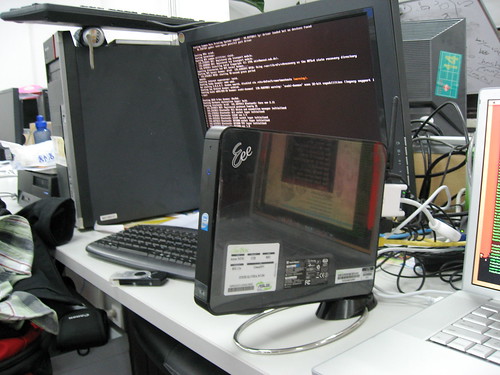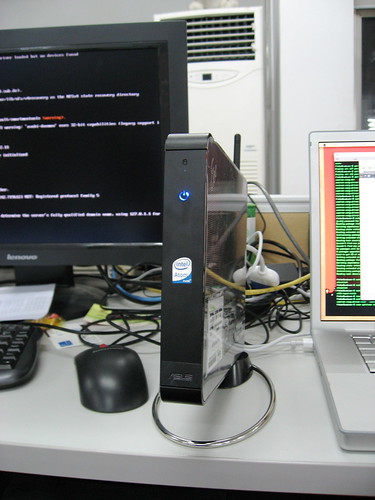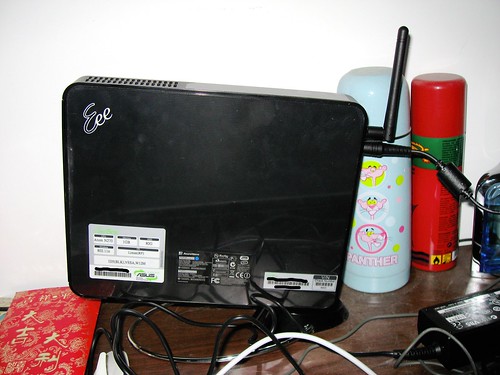Debian Lenny on Asus Eee Box
UPDATE: now we have 802.11n!
My old home server is dying these days, so I bought a new Asus Eee Box B202 to replace it. It uses Intel Atom N270 CPU, 1G memory, 80G harddisk, 10/100/1000 Ethernet and 802.11n wireless.
The first thing I do on it is install Debian Lenny, my favourite system for server.
Preparing USB flash for net install
As it didn't come with a cd-rom, I choose USB flash. I use the SD card from my camera and a USB card reader to combine a USB flash, and it can be used to boot successfully.
I prepared the USB flash according to the Debian Lenny documentation, but meet some problems:
- Google for hd-media returned the hd-media link for Sarge as the first result, I used the boot.img.gz from Sarge and lenny-businesscard iso but the iso can't be found by the installer, so the installer (boot.img.gz) and the iso must match.
- The hd-media from Lenny and the Lenny beta2 iso didn't match, neither. The installer can recognize the iso, but complain about mismatched kernel version, and prompt you that it need network update. But the installer from boot.img.gz didn't come with ethernet driver, so it will fail and can't continue.
So finally I have to use "the flexible way" and net install. I use the initrd.gz that have ethernet driver, and the vmlinuz from Lenny hd-media. None of the iso is needed (and you can't use them), all packages will be downloaded from one of the Debian mirrors.
After prepared the USB flash, DON'T FORGET to lock the write protection lock before boot. It will save your life later.
Install Debian
Boot from the prepared USB flash, and it contains only GRUB CLI, so you need to boot the installer manually:
root (hd0,0)
kernel /vmlinuz
initrd /initrd.gz
boot
Now you have a Debian Installer that can drive your ethernet card, so you're ready to install.
Install steps are normal, nothing more to say until the grub-install step.
grub-install failure
On the grub-install step, it will complain that grub-install (hd0) failed. Why? cause (hd0) is your USB flash and (hd1) is your harddisk! That's why lock the write-protection lock is important, or otherwise it may succeed without write your harddisk mbr. That's really stupid. Manually install grub on (hd1) and it will continue.
And the installation completes.
The X problem
After installation, you may find that your X didn't work. This is because it uses a Intel Graphic chipset for lap-top, but it's not lap-top. Ubuntu wiki have the solution, and it works.
Wireless driver
UPDATE: follow my next blog article for official driver and 802.11n!
After installation, the first important thing to do is to drive the wireless card. It uses AzureWare card which uses a rt2860 chipset. And luckily, ndiswrapper can do it.
Follow the instructions on Debian wiki to install ndiswrapper. The Windows driver is on the CD (you have another computer to read the CD and copy the driver to the Eee Box, do you?), I used the WIN2KXP one. After install ndiswrapper, it works.
But there are some problem in the /etc/network/interfaces, if you use WPA (I didn't get thie problem when using WEP):
auto wlan0
iface wlan0 inet static
address 10.0.14.14
netmask 255.255.255.0
gateway 10.0.14.1
wpa-conf /etc/wpa_supplicant.conf
The configure above can be used to connect router (that I can see it from router admin), but the IP 10.0.14.14 can't be reached by another computer in the subnet. But if you execute an extra:
# ifconfig wlan0 10.0.14.14
Then it will be OK. I don't know why but if I move the "auto wlan0" line after the "wpa-conf" line, it works fine. Maybe it must wait wpa-supplicant to do something first?
Another problem is that it can only use 802.11g wireless, if anyone knows how to drive it to 802.11n, please tell me :)
The end and photos
Finally, I have a new home server now.






